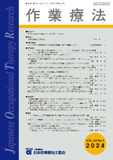Japanese
English
- 販売していません
- Abstract 文献概要
- 1ページ目 Look Inside
- 参考文献 Reference
要旨:本研究は,鏡視下腱板修復術を行った83例を対象に術後6ヵ月の運動機能の改善が術後1年のDisabilities of the Arm, Shoulder, and Hand(以下,DASH)の改善に与える影響と目標値を調査することを目的とした.術前から術後1年のDASHの改善の有無で2群に分類し,ロジスティック回帰分析で術後6ヵ月の肩関節可動域,筋力,疼痛の改善度と再断裂の有無が与える因子を検討した.結果,有意な変数として外転筋力と疼痛の改善度,再断裂の有無が抽出された.ROC曲線でカットオフ値を算出し,外転筋力,疼痛(以下,NRS)の改善が0.25 N/kg,2.00となった.本研究の結果から術後6ヵ月の外転筋力と疼痛の改善,再断裂の有無が術後1年のDASHの改善に重要であると示唆された.
The aim of this study was to investigate the effects of the factors that influence the improvement in motor function at 6 months after arthroscopic rotator cuff repair (ARCR) on the improvement in the disabilities of the arm, shoulder, and hand (DASH) score at 1 year postoperatively. Methods: A total of 83 patients who underwent ARCR and postoperative rehabilitation were included in the study. The patients were classified into two groups according to whether or not their DASH scores improved from the preoperative period to 1 year postoperatively. The effect of improvement in shoulder range of motion, strength, and pain, as well as the presence or absence of re-tear at 6 months after surgery on improvement in DASH scores at 1 year postoperatively was examined using logistic regression analysis. Results: Logistic regression analysis revealed that improvement in shoulder abduction strength, and pain, as well as the presence or absence of re-tear were all significantly related to the improvement in DASH scores at 1 year postoperatively. Furthermore, the cut-off values calculated using receiver operating characteristic curve analysis were 0.25 N/kg for shoulder abduction strength improvement and 2.00 for pain reduction. Conclusion: Results suggest that improvement in shoulder abduction strength, pain reduction, and absence of re-tear at 6 months after surgery are important for improving the DASH score 1 year after surgery.

Copyright © 2024, Japanese Association of Occupational Therapists. All rights reserved.


